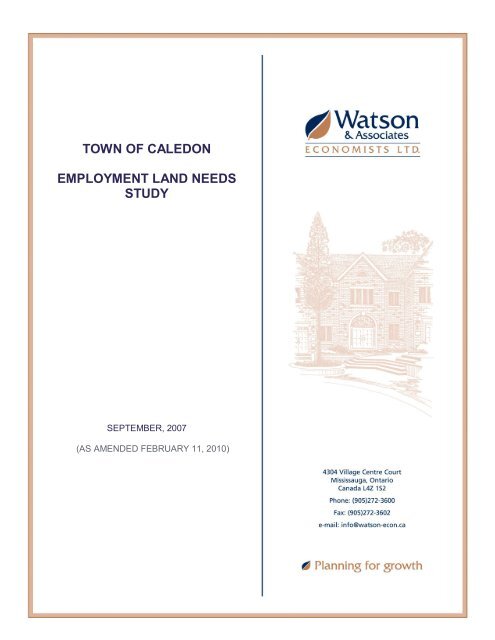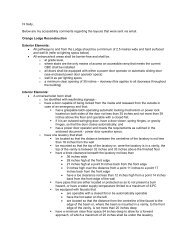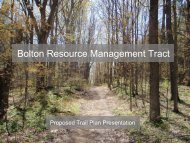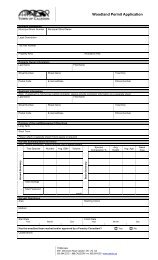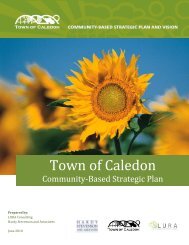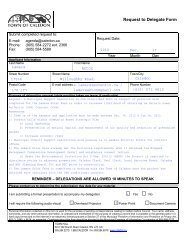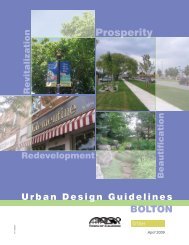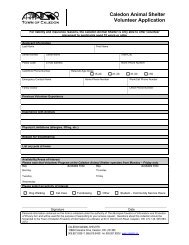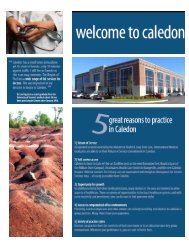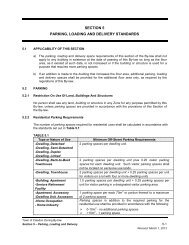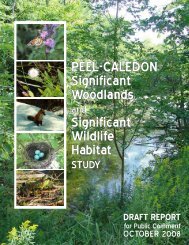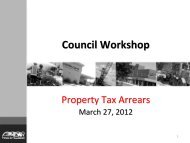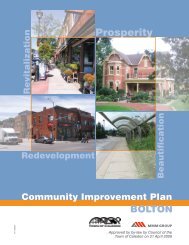TOWN OF CALEDON EMPLOYMENT LAND NEEDS STUDY
TOWN OF CALEDON EMPLOYMENT LAND NEEDS STUDY
TOWN OF CALEDON EMPLOYMENT LAND NEEDS STUDY
Create successful ePaper yourself
Turn your PDF publications into a flip-book with our unique Google optimized e-Paper software.
<strong>TOWN</strong> <strong>OF</strong> <strong>CALEDON</strong><br />
<strong>EMPLOYMENT</strong> <strong>LAND</strong> <strong>NEEDS</strong><br />
<strong>STUDY</strong><br />
SEPTEMBER, 2007<br />
(AS AMENDED FEBRUARY 11, 2010)
ADDENDUM REPORT<br />
SUMMARY <strong>OF</strong> CHANGES MADE TO THE SEPTEMBER, 2007<br />
<strong>TOWN</strong> <strong>OF</strong> <strong>CALEDON</strong> <strong>EMPLOYMENT</strong> <strong>LAND</strong> <strong>NEEDS</strong> <strong>STUDY</strong><br />
1. BACKGROUND<br />
The purpose of this addendum is to report on the changes made to the draft September, 2007<br />
Town of Caledon Employment Land Needs Study. These refinements collectively result from<br />
the consideration of comments received on the draft report since September, 2007 that were<br />
made by Town staff, Municipal Council, stakeholder groups and members of the public.<br />
2. TIMELINE<br />
The following provides a brief timeline of the key events which have occurred related to the<br />
Caledon Employment Land Needs Study since September, 2007.<br />
<br />
September 25, 2007 Council Meeting - Presentation given by Watson & Associates<br />
Economists Ltd. (W&A) regarding the key findings of the Draft September, 2007 Town of<br />
Caledon Employment Land Needs Study.<br />
<br />
<br />
November 12, 2007 Community Meeting – Presentation given by Watson &<br />
Associates Economists Ltd. (W&A) to members of the public and stakeholder groups<br />
regarding the key findings of the Draft September, 2007 Town of Caledon Employment<br />
Land Needs Study.<br />
February 19, 2008 Caledon Employment Lands Council Workshop – Key issues<br />
discussed include:<br />
o Input Received from November 12, 2007 Community Meeting;<br />
o Comments/Inquiries from Landowners and the Industrial Development<br />
Community;<br />
o Methodological Issues Related to Calculating Employment Land Needs;<br />
Watson & Associates Economists Ltd. H:\caledon\2009 Employment Land Needs Addendum<br />
Report\Addendum Report_Caledon Employment Land Needs Study_revised.docx
2.<br />
o The Impact of Low-Density Warehousing and Logistics Development on Forecast<br />
Employment Density Levels; and<br />
o Next Steps – Considerations.<br />
November 11, 2008 Caledon Employment Lands Council Workshop - In response to the<br />
comments received from Town staff, Municipal Council, stakeholder groups and members of the<br />
public, changes were made to the September 25, 2007 report where considered appropriate<br />
and presented to Council. Key refinements include:<br />
o Response to Comments Received from Landowners and the Industrial<br />
Development Community Regarding the Lack of Forecast Employment Land<br />
Needs for Bolton, Mayfield West, Tullamore and the Rural Area;<br />
o Results of the 2006 Census Employment Data;<br />
o Recent Development Trends on Employment Lands in Caledon;<br />
o Reduction to Forecast Average Density on Employment Lands;<br />
o Dry Industrial Land Needs; and<br />
o Revisions to Employment Land Needs Analysis.<br />
These refinements are summarized in the November 11, 2008 presentation (provided herein).<br />
The revised pages of the September, 2007 draft have also been provided as part of this<br />
addendum.<br />
3. REVISIONS TO THE SEPTEMBER, 2007 DRAFT<br />
<strong>EMPLOYMENT</strong> <strong>LAND</strong> <strong>NEEDS</strong> <strong>STUDY</strong><br />
In consultation with Town staff the following pages of the September, 2007 report has been<br />
amended as follows:<br />
1. Executive Summary (pages iii, v, and vii)<br />
Changes made to reflect revisions to employment land needs in Chapter 7.<br />
2. Employment Land Supply (Chapter 5, page 5-3, Table 5-2a)<br />
<br />
Dry Industrial and General Industrial employment land supply mislabelled.<br />
Watson & Associates Economists Ltd. H:\caledon\2009 Employment Land Needs Addendum<br />
Report\Addendum Report_Caledon Employment Land Needs Study_revised.docx
3.<br />
Column labelled Gross vacant + Occupied re-labelled to Gross vacant + Net<br />
Occupied for Tables 5-2a through 5-2e.<br />
3. Employment Land Needs (Chapter 7, pages 7-3, 7-4, 7-5, 7-6, 7-8. 7-9, 7-12 and 7-<br />
13). For convenience, Chapter 7 is included in its entirety.<br />
Revisions are a result of a reduction in the average forecast employment density<br />
on employment lands in Mayfield West and Tullamore in response to recent<br />
market trends and anticipated development activity for these areas.<br />
Correction to employment land supply in the remaining rural area from 81 net<br />
acres (33 net Ha) to 61 net acres (25 net Ha).<br />
4. Conclusions (Chapter 8, pages 8-2, 8-4, 8-5). For convenience, Chapter 8 is<br />
included in its entirety.<br />
Changes made to reflect revisions to employment land needs in Chapter 7.<br />
Watson & Associates Economists Ltd. H:\caledon\2009 Employment Land Needs Addendum<br />
Report\Addendum Report_Caledon Employment Land Needs Study_revised.docx
<strong>TOWN</strong> <strong>OF</strong> <strong>CALEDON</strong><br />
<strong>EMPLOYMENT</strong> <strong>LAND</strong><br />
<strong>NEEDS</strong> <strong>STUDY</strong><br />
Council Workshop<br />
November 11, 2008
WATSON & ASSOCIATES<br />
Intro/Background<br />
OUTLINE<br />
Summary of Comments Received<br />
2006 Census Employment<br />
Recent Development Trends on<br />
Employment Lands in Caledon<br />
Revisions to Employment Land Needs<br />
Analysis<br />
1
Introduction<br />
Employment Land Needs Study Undertaken by Watson<br />
& Associates Economists Ltd.<br />
Objective of study is to analyze the adequacy of the<br />
existing employment land supply in Caledon and<br />
determine the need to designate new employment areas<br />
from 2008-2031.<br />
Draft study released September 25, 2007 and presented<br />
at the Public Information Meeting November 12, 2007.<br />
Council Workshop held on February 19, 2008.<br />
2
Summary of Comments Received<br />
Bolton/South Albion<br />
• Recommended adjustments and feedback from<br />
landowner groups regarding draft employment land<br />
location options in Bolton South-Albion.<br />
Mayfield West<br />
• Additional employment lands are needed in Mayfield<br />
West prior to 2021.<br />
Tullamore<br />
• Additional Lands are needed in Tullamore on both<br />
east and west side of Airport Rd.
Summary of Comments Received<br />
Victoria and Sandhill<br />
• Weston Consulting Group Inc. - Requesting and<br />
expansion to Victoria and Sandhill of 549 acres and<br />
24 acres, respectively.<br />
• Weston has provided a report by urbanMetrics titled<br />
“Dry Industrial Land Needs Analysis, Communities of<br />
Victoria and Sandhill.”
Summary of Comments Received<br />
Region of Peel<br />
• No formal comments received to date.<br />
• Informal comments received from MKI (Region of<br />
Peel Consultant), including:<br />
Employment forecast appears aggressive;<br />
Mayfield West density assumptions appear high;<br />
and<br />
Annual employment absorption levels appear<br />
reasonable.
2006 Census Employment<br />
Caledon’s employment base (i.e. jobs in Caledon)<br />
reached 18,550 in mid 2006 (as per 2006 Census).<br />
This represents an increase of approx. 2,100 employees<br />
from 2001.<br />
Comparatively the 2006 Census employment number is<br />
2,350 jobs less than W&A’s 2006 estimate (20,890) as<br />
per Sept. 2007 Draft Report.
2006 Census Employment<br />
Components of 1996-2001 vs. 2001-2006 Employment<br />
Growth in Caledon<br />
1996-2001<br />
11%<br />
65%<br />
24%<br />
2,945<br />
New<br />
jobs<br />
2001-2006<br />
14%<br />
22%<br />
64%<br />
2,110<br />
New<br />
jobs<br />
0 1,000 2,000 3,000 4,000<br />
Primary/Work at Home Industrial Commercial/Institutional
Recent Development Trends on<br />
Employment Lands in Caledon<br />
Recent demand for employment lands in Bolton and<br />
Tullamore have been very strong.<br />
From June 2007 to April 2008 the Town has absorbed<br />
approx. 106 net acres (43 Ha) of employment on<br />
employment lands.<br />
The majority of recent development activity on the<br />
Town’s employment lands has been dominated by the<br />
warehousing/distribution and transportation sector.<br />
• e.g. AMB, Giffels, Solmar, Pillsworth, Great West Life (GWL).
Recent Development Trends on<br />
Employment Lands in Caledon<br />
Bolton Industrial Area<br />
- Supply of developable<br />
employment lands, as<br />
of October 2008.
Recent Development Trends on<br />
Employment Lands in Caledon<br />
Based on discussions with Town staff, 70% of the vacant<br />
land inventory (approx. 100 Ha) in Mayfield West has<br />
been purchased by land owners with interest in<br />
developing this area for warehousing and distribution<br />
purposes.<br />
Interest also exists to develop the remaining 30% for<br />
similar purposes.
Revisions to Employment Land<br />
No adjustments are recommended with respect to the<br />
Town’s long term employment forecast.<br />
The long term employment growth outlook should be<br />
continually monitored every five years.<br />
Needs Analysis<br />
Long Term Employment Forecast
Revisions to Employment Land<br />
Employment Density on Employment Lands<br />
In accordance with recent development activity,<br />
stakeholder comments and anticipated development<br />
activity on vacant employment lands, W&A has<br />
moderately reduced the long term average employment<br />
density as follows:<br />
Needs Analysis<br />
Sept. 2007 Draft Report Recommended Final Report Sept. 2007 Draft Report Recommended<br />
Final Report<br />
Settlement Area (Emp./Net Acre)<br />
(Emp./Net Hectare)<br />
Bolton South-Albion 12 12 30 30<br />
Mayfield West 18 12 44 30<br />
Tullamore 7 5 18 12<br />
Remaining Rural 3 3 8 8<br />
Caledon Total 1 13 11 31 26<br />
1. Overall employment density is based on a weighted average.
Revisions to Employment Land<br />
Further efforts are required by the Town, Region and<br />
Province with respect to implementation of greenfield<br />
density targets in Peel Region.<br />
Needs Analysis<br />
Employment Density on Employment Lands<br />
The revised forecast density levels on employment lands<br />
represent a “best fit” between market demand and local,<br />
Regional and Provincial policy objectives.
Revisions to Employment Land<br />
Needs Analysis<br />
Dry Industrial Land Needs<br />
A total of 144 acres (58 Ha) of employment land are<br />
currently designated as “dry industrial land” in Victoria<br />
and Bolton.<br />
Over the past four years there has been no demand for<br />
dry industrial land in Caledon.<br />
Accordingly, there does not appear to be an immediate<br />
need to expand settlement area boundaries in Victoria<br />
and Sandhill to provide additional supply.
Revisions to Employment Land<br />
Needs Analysis<br />
Dry Industrial Land Needs<br />
Furthermore, there are a number of other factors which<br />
would suggest that it is premature to designate dry<br />
additional industrial lands in Caledon at this time,<br />
including:<br />
• OP Policy Objectives - Caledon OP (Section 5.10.7)<br />
“Industrial/Commercial Centres will serve a<br />
complementary role to other settlements and will<br />
provide, at a small scale, a supportive function to<br />
the Rural Service Centres for industrial and<br />
commercial development.” (underlining added)
Revisions to Employment Land<br />
The Town should revisit the role of Industrial/Commercial<br />
Centres (i.e. Victoria and Sandhill) for dry industrial lands<br />
in accordance with local needs and broader Town-wide<br />
growth objectives during subsequent comprehensive<br />
reviews.<br />
Needs Analysis<br />
Dry Industrial Land Needs (Con’t)<br />
• Uncertainty with respect to the proposed routing of<br />
the East-West GTA Highway corridor.<br />
• Impact on Caledon’s role with respect to greenfield<br />
density targets.
Revisions to Employment Land<br />
A shortfall of 1,110 gross acres (excluding environmental<br />
lands) of employment lands is forecast by 2031.<br />
This represents an increase of 370 gross acres (150 Ha)<br />
vs. Sept. 2007 Draft Report.<br />
Needs Analysis<br />
Gross Acres<br />
200<br />
0<br />
-200<br />
-400<br />
-600<br />
-800<br />
-1000<br />
Surplus/Shortfall of Employment Lands by<br />
Settlement Area<br />
2006-2031<br />
-620<br />
-290<br />
-210<br />
10<br />
-1200<br />
South Albion-Bolton Mayfield West Tullamore<br />
Remaining Rural Total Town of Caledon<br />
-1,110
Revisions to Employment Land<br />
Revised annual employment lands absorption forecast<br />
(increase of approx. 15 gross acres per year as per<br />
Sept. 2007 Draft Report).<br />
Needs Analysis<br />
Net Acres<br />
120.0<br />
100.0<br />
80.0<br />
60.0<br />
40.0<br />
20.0<br />
78<br />
89<br />
<strong>TOWN</strong> <strong>OF</strong> <strong>CALEDON</strong>, ANNUAL <strong>EMPLOYMENT</strong> <strong>LAND</strong>S ABSORPTION, 1997-2031<br />
Actual Absorption<br />
104 +100 Acres<br />
23<br />
18<br />
101<br />
16<br />
41<br />
18 17<br />
81 81 81 81 81<br />
85 85 85 85 85 85 85 85 85 85<br />
60 60 60 60 60 60 60 60 60 60<br />
0.0<br />
Remaining Rural Tullamore Mayfield West Bolton Historical Average (1997-2006)<br />
Years
AMENDED PAGES<br />
Watson & Associates Economists Ltd. H:\caledon\2009 Employment Land Needs Addendum<br />
Report\divider.docx
(iii)<br />
Demand for Employment on Employment Lands<br />
1. Forecast demand for employment on employment lands in Caledon is well above<br />
historical averages (Table 7-1b). Over the end-2006 to mid-2031 planning period, the<br />
Town of Caledon is forecast to add a total of 19,174 employees on employment lands, or<br />
767 employees per year. During the 1996 to 2006 period, the Town averaged<br />
approximately 430 additional employees on employment lands per year.<br />
2. Approximately 47% of total forecast employment land absorption has been<br />
allocated to the South Albion-Bolton Industrial Area, while 33% and 17% has been<br />
allocated to Mayfield West and Tullamore, respectively. The remaining 3% has been<br />
forecast throughout the remaining rural area.<br />
3. With respect to land demand, the Town of Caledon is forecast to absorb an annual<br />
average of 95 gross acres per year (38 gross ha/year) from 2006 to 2031.<br />
4. Average annual absorption rates are forecast to diminish over the forecast period, which<br />
is consistent with the employment growth trends for the Town, Region of Peel, and<br />
Province. For Caledon, this is largely a result of a declining employment growth rate and<br />
increasing employment density over the forecast period.<br />
Employment Land Needs<br />
The following summarizes long term land needs for employment on employment lands based on<br />
forecast demand and net developable supply within the Town of Caledon by settlement area.<br />
Recommended future employment land needs (i.e. expansion of designated land) have been<br />
calculated in gross acres/hectares (i.e. they include provisions for roads, easements, corridors,<br />
stormwater ponds). However, due to uncertainty with respect to location options for future<br />
employment lands designations, environmental lands have not been included in the gross<br />
employment land area calculations.<br />
The following key findings are provided with respect to future employment land needs by<br />
settlement area within the Town of Caledon.<br />
Watson & Associates Economists Ltd.<br />
H:\caledon\2009 Employment Land Needs Addendum<br />
Report\Employment Land Needs Report_ammended as of November 13 2009.doc
(v)<br />
2. Mayfield West<br />
2.1 Within Mayfield West, a total employment land supply of 358 net acres (145 net ha) has<br />
been proposed in the Mayfield West Secondary Plan, on the east side of the proposed<br />
Highway 410 extension.<br />
2.2 Based on an average absorption of 24 gross acres per year (10 gross ha/year), the<br />
designated employment lands within the Mayfield Secondary Plan area can<br />
accommodate future demand beyond 2021. However, in order to ensure that longterm<br />
demand is not unduly constrained within the Mayfield West, it is recommended<br />
that additional lands are designated in Mayfield West during the post 2021<br />
planning period, either through an expansion of the existing employment area<br />
located on the east side of Highway 410, or through the establishment of a new<br />
employment area on the west side of Highway 410.<br />
2.3 Over the longer-term (i.e. 2021-2031) a minimum of an additional 230 net or 290<br />
gross acres (93 net or 117 gross ha) of employment lands are recommended for<br />
the Mayfield West area. It is recommended that medium to long term employment<br />
land needs are maintained at least every five years in Mayfield West. For example,<br />
an increase in forecast employment land absorption and/or decreased<br />
employment density levels could result in greater long term employment land<br />
needs for this area.<br />
3. Tullamore and the Remaining Rural Area<br />
3.1 A total of 148 vacant net acres (60 ha) of serviced employment lands have been<br />
identified within the Tullamore Industrial Area. Based on an average absorption of 12<br />
net acres (5 ha) per year in this area, a minimum additional 150 net or 210 gross<br />
acres (60 net or 85 gross ha) of employment lands are recommended prior to<br />
2031.<br />
3.2 A total of 61 net gross developable acres (25 net ha) of serviced employment lands have<br />
been identified within the remaining rural area. Based on an average of 2 net acres<br />
per year (1 net ha) in this area, the currently designated supply of employment<br />
lands is adequate.<br />
Watson & Associates Economists Ltd.<br />
H:\caledon\2009 Employment Land Needs Addendum<br />
Report\Employment Land Needs Report_ammended as of November 13 2009.doc
Table ES-1 summarizes the Town’s employment land need requirements by Settlement Area<br />
from 2006 to 2031.<br />
(vii)<br />
TABLE ES-1<br />
<strong>EMPLOYMENT</strong> <strong>LAND</strong> REQUIREMENTS FOR THE <strong>TOWN</strong> <strong>OF</strong> <strong>CALEDON</strong> (NET ACRES), 2006-2031<br />
South Albion-Bolton A (Table 7-3) B (Table 5-2) C = B - A<br />
Year Demand (Net Acres) 1 Supply (Net Acres) 2 Net Surplus / Shortfall<br />
Net Employment Land<br />
Needs (Rounded)<br />
2006-2021 689 398 -291 -290<br />
2006-2031 864 398 -467 -470<br />
Mayfield West 0<br />
2006-2021 288 358 71 70<br />
2006-2031 592 358 -234 -230<br />
Tullamore 0<br />
2006-2021 206 148 -58 -60<br />
2006-2031 302 148 -154 -150<br />
Remaining 2006-2011 Rural 14 61 470<br />
50<br />
2006-2021 35 61 26 30<br />
2006-2031 56 61 5 0<br />
Total Town of Caledon 0<br />
2006-2021 1,217 965 -253 -250<br />
2006-2031 1,814 965 -850 -850<br />
South Albion-Bolton A B C = B - A<br />
Demand (Gross<br />
Gross Surplus / Shortfall<br />
Year<br />
Acres) 1 Supply (Gross Acres) 2 (Rounded)<br />
Gross Employment Land<br />
Needs (Rounded)<br />
2006-2021 918 530 -388 -390<br />
2006-2031 1,153 530 -623 -620<br />
Mayfield West 0<br />
2006-2021 360 448 89 90<br />
2006-2031 740 448 -292 -290<br />
Tullamore 0 0<br />
2006-2021 275 197 -77 -80<br />
2006-2031 402 197 -205 -210<br />
Remaining Rural 0<br />
2006-2021 47 81 34 30<br />
2006-2031 75 81 7 10<br />
Total Town of Caledon 0<br />
2006-2021 1,599 1,257 -343 -340<br />
2006-2031 2,370 1,257 -1,113 -1110<br />
Sources<br />
TABLE ES-1<br />
<strong>EMPLOYMENT</strong> <strong>LAND</strong> REQUIREMENTS FOR THE <strong>TOWN</strong> <strong>OF</strong> <strong>CALEDON</strong> (GROSS ACRES), 2006-2031<br />
1. Watson & Associates Economists Ltd. July, 2007.<br />
2. As provided by the Town of Caledon Economic Development Department. Based on a 75% net to gross ratio (80% for Mayfield West).<br />
Watson & Associates Economists Ltd.<br />
H:\caledon\2009 Employment Land Needs Addendum<br />
Report\Employment Land Needs Report_ammended as of November 13 2009.doc
TABLE 5-2a<br />
<strong>TOWN</strong> <strong>OF</strong> <strong>CALEDON</strong><br />
VACANT <strong>EMPLOYMENT</strong> <strong>LAND</strong> INVENTORY (ACRES)<br />
(July, 2007)<br />
Community<br />
OP Schedule Designation<br />
Net<br />
Occupied<br />
Gross<br />
Vacant<br />
Net<br />
Vacant 2<br />
Gross<br />
Vacant +<br />
Net<br />
Occupied<br />
Land<br />
Vacancy<br />
Adjustment 3<br />
Total Net Vacant<br />
Employment<br />
Lands Adjusted<br />
for Land Vacancy<br />
Bolton C General Industrial 302 44.6 33 347 17 16<br />
Bolton C Dry Industrial 1 111 521.0 391 632 32 359<br />
Bolton C Prestige Industrial 351 56.9 43 408 20 22<br />
Mayfield West D General Industrial 0 159.6 120 160 8 112<br />
Mayfield West D Prestige Industrial 0 352.5 264 353 18 247<br />
Tullamore N Prestige Industrial 8 50.3 38 58 3 35<br />
Tullamore N General Industrial 27 163.5 123 191 10 113<br />
Victoria Figure 16 Industrial Policy Area 0 87.0 65 87 4 61<br />
Total Total 800 1,435 1,077 2,235 112 965<br />
Source: Town of Caledon Economic Development Dept. July, 2007.<br />
1. Extension of services for employment lands which are identified as "dry" would be developer driven.<br />
2. Includes changes to designated lands from OPA 215.<br />
3. 5% of total occupied + vacant.<br />
TABLE 5-2b<br />
BOLTON<br />
<strong>EMPLOYMENT</strong> <strong>LAND</strong> INVENTORY - VACANT/OCCUPIED (ACRES)<br />
Community OP Schedule Designation<br />
Net<br />
Occupied<br />
Gross<br />
Vacant<br />
Net<br />
Vacant 2<br />
Gross<br />
Vacant +<br />
Net<br />
Occupied<br />
Land<br />
Vacancy<br />
Adjustment<br />
Total Net Vacant<br />
Employment<br />
Lands Adjusted<br />
for Land Vacancy<br />
Bolton C General Industrial 302 45 33 347 17 16<br />
Bolton C Dry Industrial 111 57 43 632 20 22<br />
Bolton C Prestige Industrial 351 521 391 408 32 359<br />
Bolton Total 765 622 467 1,387 69 398<br />
Source: Town of Caledon Economic Development Dept. July, 2007.<br />
TABLE 5-2c<br />
MAYFIELD WEST<br />
<strong>EMPLOYMENT</strong> <strong>LAND</strong> INVENTORY - VACANT/OCCUPIED (ACRES)<br />
Community OP Schedule Designation<br />
Net<br />
Occupied<br />
Gross<br />
Vacant<br />
Net<br />
Vacant 2<br />
Gross<br />
Vacant +<br />
Net<br />
Occupied<br />
Land<br />
Vacancy<br />
Adjustment<br />
Total Net Vacant<br />
Employment<br />
Lands Adjusted<br />
for Land Vacancy<br />
Mayfield West General Industrial 0 160 120 120 8 112<br />
Mayfield West Prestige Industrial 0 353 264 264 18 247<br />
Mayfield West Total 0 512 384 384 26 358<br />
TABLE 5-2d<br />
TULLAMORE<br />
<strong>EMPLOYMENT</strong> <strong>LAND</strong> INVENTORY - VACANT/OCCUPIED (ACRES)<br />
Community OP Schedule Designation<br />
Net<br />
Occupied<br />
Gross<br />
Vacant<br />
Net<br />
Vacant 2<br />
Gross<br />
Vacant +<br />
Net<br />
Occupied<br />
Land<br />
Vacancy<br />
Adjustment<br />
Total Net Vacant<br />
Employment<br />
Lands Adjusted<br />
for Land Vacancy<br />
Tullamore Prestige Industrial 8 50 38 46 3 35<br />
Tullamore General Industrial 27 164 123 150 10 113<br />
Tullamore Total 35 214 160 195 12 148<br />
TABLE 5-2e<br />
REMAINING RURAL<br />
<strong>EMPLOYMENT</strong> <strong>LAND</strong> INVENTORY - VACANT/OCCUPIED (ACRES)<br />
Community OP Schedule Designation<br />
Net<br />
Occupied<br />
Gross<br />
Vacant<br />
Net<br />
Vacant 2<br />
Gross<br />
Vacant +<br />
Net<br />
Occupied<br />
Land<br />
Vacancy<br />
Adjustment<br />
Total Net Vacant<br />
Employment<br />
Lands Adjusted<br />
for Land Vacancy<br />
Remaining Rural Industrial Policy Area 0 87 65 65 4 61<br />
Remaining Rural Total 0 87 65 65 4 61<br />
Watson & Associates Economists Ltd.<br />
H:\caledon\2009 Employment Land Needs Addendum Report\<br />
Employment Forecast by Settlement Area_Oct 08.xls
7. <strong>TOWN</strong> <strong>OF</strong> <strong>CALEDON</strong> <strong>EMPLOYMENT</strong> <strong>LAND</strong> <strong>NEEDS</strong>,<br />
2006-2031<br />
Watson & Associates Economists Ltd.<br />
H:\caledon\2009 Employment Land Needs Addendum<br />
Report\Employment Land Needs Report_ammended as of November 13 2009.doc
7-1<br />
7. <strong>TOWN</strong> <strong>OF</strong> <strong>CALEDON</strong> <strong>EMPLOYMENT</strong> <strong>LAND</strong> <strong>NEEDS</strong>,<br />
2006-2031<br />
7.1 Introduction<br />
Chapter 7 summarizes total employment land needs within the Town of Caledon to 2031 based<br />
on the employment supply and demand analysis provided in Chapters 5 and 6. This analysis<br />
identifies additional employment lands (i.e. expansion areas) in gross acres/hectares which are<br />
required outside of currently designated employment areas for South Albion-Bolton, Mayfield<br />
West and Tullamore.<br />
7.2 Employment on Employment Lands<br />
In generating employment land area requirements for the Town of Caledon, the following steps<br />
have been undertaken:<br />
1. Remove Work at Home Employment and No Fixed Place of Work Employment<br />
As identified in Chapter 6, employment growth has been categorized into four broad categories<br />
including; primary, industrial, commercial, and institutional based on 2001 Census data. These<br />
categories have been aggregated from specific employment sub-classifications based on the<br />
North American Industrial Classification (NAIC) system. 1 As a first step, all estimated “Work at<br />
Home” has been excluded from the employment land needs analysis, as these employees do<br />
not require land in the Town’s designated employment areas. “No Fixed Place of Work<br />
Employees”, e.g. landscape contractors, traveling salespersons, independent truck drivers, etc.<br />
are also excluded from the base employment figures as provided in Tables 6-1 and 6-2. Similar<br />
to Work at Home employees, these employees are not anticipated to have an impact on longterm<br />
employment land needs in Caledon.<br />
1 Employment by NIAC has been converted to Standard Industrial Classification (SIC) to be consistent<br />
with historical employment data (i.e. 1991 and 1996).<br />
Watson & Associates Economists Ltd.<br />
H:\caledon\2009 Employment Land Needs Addendum<br />
Report\Employment Land Needs Report_ammended as of November 13 2009.doc
2. Determine the amount of industrial, commercial and institutional (ICI) employees<br />
to be employed on employment lands<br />
7-2<br />
As previously identified, current definitions of employment lands have broadened to include a<br />
number of commercial uses (and to a lesser extent institutional uses) in addition to traditional<br />
industrial development. For example, a number commercial and institutional uses (as defined by<br />
Statistics Canada) are permitted on employment lands within the Town of Caledon, such as<br />
business offices (i.e. finance and insurance industries, dry cleaning or laundry facilities, motor<br />
vehicle repairs shops, restaurants, gas stations, places of worship, places of assembly, etc.). 1<br />
Alternatively, a small portion of industrial employment (e.g. prestige office) is anticipated to<br />
locate on commercially designated zoned lands, i.e. business office and warehousing (permitted<br />
on Bolton Highway Commercial Zones). Actual data is not available from the Town of Caledon<br />
with respect to the precise amount and breakdown of existing ICI employment on employment<br />
lands.<br />
Accordingly, Watson & Associates has relied on data sources in other GTAH<br />
municipalities to develop a reasonable conversion of future employment by ICI sector to<br />
employment on employment lands. 2<br />
assumed by ICI on employment lands over the 2006 to 2031 period:<br />
The following employment percentages have been<br />
TABLE 7-1a<br />
<strong>EMPLOYMENT</strong> BY ICI ON <strong>CALEDON</strong><br />
<strong>EMPLOYMENT</strong> <strong>LAND</strong>S<br />
Employment<br />
Sector<br />
Employment on<br />
Employment Lands<br />
Industrial 97%<br />
Commercial 25%<br />
Institutional 10%<br />
Source: Watson and Associates. 2007.<br />
Based on permitted uses in Caledon<br />
Comprehensive Zoning By-Law 2006-<br />
50, plus review of employment areas in<br />
other GTA jurisdictions.<br />
1 A detailed list of commercial/institutional uses permitted on industrial lands, as per Town of Caledon<br />
Zoning By-Law 2006-50, is provided in Appendix C.<br />
2 It is important to note that Watson & Associates does not provide a specific employment category<br />
related to “Major Office” Employment (i.e. freestanding office buildings 10,000 m 2 or greater, or with 500<br />
jobs or more), as provided in the 2005 Growth Outlook for the GGH. For the purposes of this analysis, the<br />
majority of potential major office employment in Caledon would be located on employment lands.<br />
Watson & Associates Economists Ltd.<br />
H:\caledon\2009 Employment Land Needs Addendum<br />
Report\Employment Land Needs Report_ammended as of November 13 2009.doc
7-3<br />
Table 7-1b summarizes Watson’s forecast of employment on employment lands over the shortterm<br />
and long-term forecast period, based on the conversion factors assigned to employment by<br />
ICI, as set out in Table 7-a.<br />
TABLE 7-1b<br />
<strong>EMPLOYMENT</strong> ON <strong>EMPLOYMENT</strong> <strong>LAND</strong>S, 2006-2031<br />
Percent Total Employment Growth on Employment<br />
Employment Growth by Sector<br />
Employment on<br />
Lands<br />
Employment by ICI 2006-2011 2006-2021 2006-2031 Employment Lands 2006-2011 2006-2021 2006-2031<br />
Primary 10 63 169 0% 0 0 0<br />
Work @ Home 868 2,030 3,544 0% 0 0 0<br />
Industrial 3988 11,894 18,598 97% 3,868 11,537 18,040<br />
Commercial 715 2,185 3,941 25% 179 546 985<br />
Institutional 351 909 1,479 10% 35 91 148<br />
Total 5,931 17,081 27,731 4,082 12,174 19,174<br />
Source: Watson & Associates, 2008.<br />
3. Determine the Density of Employment on Employment Lands<br />
Over the forecast period, there are a number of factors which are anticipated to influence the<br />
physical nature of development on employment lands across the Region of Peel. For example,<br />
it is foreseeable that higher density on employment lands could be achieved throughout the<br />
forecast period in the Region’s larger urban municipalities, largely due to the tightening of<br />
available employment land supply, increasing pressure for intensification. An increasing trend<br />
of office commercial uses in newer business parks is also likely to provide higher densities in<br />
employment areas with direct 400 series highway exposure, such as Mayfield West, when<br />
compared to older, heavier, traditional industrial areas. Furthermore, increases in industrial land<br />
values in Caledon (which have recently been experienced in South Albion-Bolton) will also tend<br />
to improve land utilization and increase employment density. On the other hand, existing trends<br />
within the Peel municipalities of Caledon and Brampton indicate that overall employment density<br />
has been, and will continue to be, heavily influenced by an increasing percentage of landextensive<br />
employment within the distribution and warehousing sector, which will tend to counter<br />
trends towards higher employment density.<br />
Given the above factors, forecast employment land density within the Town of Caledon is<br />
anticipated to be below many of the larger urban GTAH municipalities such as Brampton,<br />
Mississauga, and Vaughan, which range from approximately 14 to 24 employees per net acre<br />
Watson & Associates Economists Ltd.<br />
H:\caledon\2009 Employment Land Needs Addendum<br />
Report\Employment Land Needs Report_ammended as of November 13 2009.doc
(35 to 60 employees per net ha). The following employment densities have been assumed over<br />
the forecast period for the Town of Caledon by settlement area:<br />
7-4<br />
TABLE 7-2<br />
FORECAST <strong>EMPLOYMENT</strong> DENSITIES ON <strong>EMPLOYMENT</strong><br />
<strong>LAND</strong>S, 2006-2031<br />
Settlement Area<br />
Employment<br />
Density<br />
(Employees per<br />
Net Acre)<br />
Employment<br />
Density (Employees<br />
per Net Hectare)<br />
South Albion-Bolton 12.0 29.7<br />
Mayfield West 12.0 29.7<br />
Remaining Rural 3.3 8.2<br />
Tullamore 5.0 12.4<br />
Total 1 10.6 26.1<br />
Source: Watson & Associates, 2008.<br />
4. Determine Net Developable Employment Land Supply over both Short-Term and<br />
Long-Term Forecast Period (Adjusted for Land Vacancy)<br />
Chapter 5 provided a detailed analysis of the gross and net developable employment land<br />
supply (i.e. excluding all environmental lands, internal roads, corridors, easements and<br />
stormwater ponds) for the Town of Caledon by Employment Area as of November, 2006. In<br />
summary, the Town has a total net developable employment land supply of 965 net acres (390<br />
net ha). The employment land supply analysis provided in Chapter 5 identified that within the<br />
Bolton Industrial Area, a large percentage of the identified “vacant” employment land supply is<br />
not readily available (i.e. lands have been sold and/or are not currently serviced). Accordingly,<br />
the short-term available employment land supply within Bolton has been reduced to 170 net<br />
acres (69 ha) (as per Table 5-3).<br />
5. Provide a Provision for Market Choice Over the Long-Term Land Needs Forecast<br />
Chapter 5 provided a detailed analysis with respect to the need to include a market choice<br />
provision, in order to ensure proper market functioning. As demonstrated within the Bolton<br />
Industrial Area, a significant portion of the Town’s vacant supply is presently not serviced, has<br />
been sold, or is currently tied up by existing land owners (i.e. being held for future expansion).<br />
Watson & Associates Economists Ltd.<br />
H:\caledon\2009 Employment Land Needs Addendum<br />
Report\Employment Land Needs Report_ammended as of November 13 2009.doc
7-5<br />
In addition, several of the remaining parcels of land which are available for development are<br />
small, poorly configured, and fragmented. While this observation applies specifically to the<br />
South Albion-Bolton Industrial Area, over time it is foreseeable that the Town’s other<br />
employment areas (i.e. Mayfield West, and Tullamore) will also begin to exhibit these<br />
characteristics. In order to allow for proper market functioning, it is our opinion that the Town<br />
should ensure that a minimum five-year supply of serviced and available employment lands (by<br />
various sizes, zoning and locations) is available at all times throughout the forecast period. This<br />
is to ensure that the Town’s employment demand is not unduly constrained by a lack of<br />
appropriately designated supply. Over the forecast period, it is recommended that the Town<br />
review its inventory of serviced employment lands every five years.<br />
6. Calculate Total Demand for Employment Lands Employment<br />
Table 7-3 summarizes forecast demand for employment lands employment and associated land<br />
area requirements by Settlement Area from 2006 to 2031, in accordance with the assumptions<br />
set out through steps 1 through 5. Key observations include:<br />
<br />
Over the 2006 to 2031 planning period, the Town of Caledon is forecast to add a total of<br />
19,174 employees on employment lands;<br />
<br />
Based on future absorption potential, approximately 47% of total forecast employment<br />
land has been allocated to the South Albion-Bolton Industrial Area, while 33% and 17%<br />
has been allocated to Mayfield West and Tullamore, respectively. The remaining 3% has<br />
been forecast throughout the remaining rural area;<br />
<br />
With respect to land demand, the Town of Caledon is forecast to absorb an annual<br />
average of 72.6 net acres per year (29.3 net ha/year) from 2006 to 2031 (72.6 acres X<br />
25 years = 1,815 (Table 7-3)). 1 Bolton and Mayfield West, the Town’s largest future<br />
employment areas, are forecast to absorb 80% of the total Town-wide employment<br />
lands forecast.<br />
1 Absorption figures have been rounded.<br />
Watson & Associates Economists Ltd.<br />
H:\caledon\2009 Employment Land Needs Addendum<br />
Report\Employment Land Needs Report_ammended as of November 13 2009.doc
TABLE 7-3<br />
<strong>TOWN</strong> <strong>OF</strong> <strong>CALEDON</strong><br />
FORECAST <strong>EMPLOYMENT</strong> DEMAND ON <strong>EMPLOYMENT</strong> <strong>LAND</strong>S, 2006-2031<br />
Settlement Area<br />
Industrial<br />
Employees on<br />
Employment<br />
Lands<br />
Commercial/ Institutional<br />
Employees on<br />
Employment Lands<br />
2006-2011<br />
Total Employment<br />
on Employment<br />
Lands Employees/ Net Acre<br />
Employees/ Net<br />
Ha<br />
Total<br />
Employment<br />
Land Needs<br />
(Net Acres)<br />
Total<br />
Employment<br />
Land Needs<br />
(Net Ha)<br />
Annual<br />
Employment Land<br />
Absorption (Net<br />
Acres)<br />
Annual<br />
Employment<br />
Land Absorption<br />
(Net Ha)<br />
South Albion-Bolton 2,813 155 2,969 11 27 270 109 54 22<br />
Caledon East 0 0 0 0 0 0 0 0 0<br />
Mayfield West 733 40 773 12 30 64 26 13 5<br />
Remaining Rural 45 2 47 3 8 14 6 3 1<br />
Tullamore 277 15 293 5 12 59 24 12 5<br />
Total 1 3,868 214 4,082 10 25 407 165 81 33<br />
Settlement Area<br />
Industrial<br />
Employees on<br />
Employment<br />
Lands<br />
Commercial/ Institutional<br />
Employees on<br />
Employment Lands<br />
2006-2021<br />
Total Employment<br />
on Employment<br />
Lands Employees/Net Acre<br />
Employees/ Net<br />
Ha<br />
Total<br />
Employment<br />
Land Needs<br />
(Net Acres)<br />
Total<br />
Employment<br />
Land Needs<br />
(Net Ha)<br />
Annual<br />
Employment Land<br />
Absorption (Net<br />
Acres)<br />
Annual<br />
Employment<br />
Land Absorption<br />
(Net Ha)<br />
South Albion-Bolton 7,181 397 7,578 11 27 689 279 46 19<br />
Caledon East 0 0 0 0 0 0 0 0 0<br />
Mayfield West 3,271 181 3,451 12 30 288 116 19 8<br />
Remaining Rural 110 6 116 3 8 35 14 2 1<br />
Tullamore 976 54 1,030 5 12 206 83 14 6<br />
Total 1 11,537 637 12,174 11 26 1,217 493 81 33<br />
Settlement Area<br />
Industrial<br />
Employees on<br />
Employment<br />
Lands<br />
Commercial/ Institutional<br />
Employees on<br />
Employment Lands<br />
Total Employment<br />
on Employment<br />
Lands Employees/Net Acre<br />
Employees/ Net<br />
Ha<br />
Total<br />
Employment<br />
Land Needs<br />
(Net Acres)<br />
Total<br />
Employment<br />
Land Needs<br />
(Net Ha)<br />
Annual<br />
Employment Land<br />
Absorption (Net<br />
Acres)<br />
Annual<br />
Employment<br />
Land Absorption<br />
(Net Ha)<br />
South Albion-Bolton 9,779 595 10,374 12 30 864 350 35 14<br />
Caledon East 0 0 0 0 0 0 0 0 0<br />
Mayfield West 6,666 440 7,105 12 30 592 240 24 10<br />
Remaining Rural 174 11 185 3 8 56 23 2 1<br />
Tullamore 1,421 88 1,509 5 12 302 122 12 5<br />
Total 1 18,040 1,133 19,174 11 26 1,814 734 73 29<br />
Source: Watson & Associates, 2006.<br />
1. Total employment density is based on a weighted average.<br />
2006-2031<br />
Employment Forecast by Settlement Area_Oct 08.xls
7-7<br />
Average annual absorption rates are forecast to diminish over the forecast period, which is<br />
consistent with the employment growth trends for the Town, Region of Peel, and Province. For<br />
Caledon, this is largely a result of a declining employment growth rate and increasing<br />
employment density over the forecast period. Figure 7-1 summarizes forecast annual<br />
employment lands absorption for the Town of Caledon from 2006 to 2031.<br />
7.3 Employment Land Needs within the Town of Caledon, 2006 to<br />
2031<br />
Tables 7-4a and 7-4b summarize short and long-term land needs for employment on<br />
employment lands based on forecast demand and net developable supply within the Town of<br />
Caledon by Settlement Area. The analysis identifies additional employment lands, i.e.<br />
employment expansions areas) which will need to be designated by the Town outside of current<br />
urban boundaries in order for supply to match anticipated demand. Recommended future<br />
employment land needs have been calculated in gross acres/hectares (i.e. they include<br />
provisions for roads, easements, corridors, stormwater ponds). However, due to the uncertainty<br />
with respect to location options for future employment lands designations, environmental lands<br />
have not been included in the gross employment land area calculations. The following key<br />
findings are provided with respect to future employment land needs by Employment Area within<br />
the Town of Caledon:<br />
Watson & Associates Economists Ltd.<br />
H:\caledon\2009 Employment Land Needs Addendum<br />
Report\Employment Land Needs Report_ammended as of November 13 2009.doc
Net Acres<br />
120.0<br />
100.0<br />
80.0<br />
60.0<br />
40.0<br />
20.0<br />
78<br />
89<br />
FIGURE 7-1<br />
<strong>TOWN</strong> <strong>OF</strong> <strong>CALEDON</strong>, ANNUAL <strong>EMPLOYMENT</strong> <strong>LAND</strong>S ABSORPTION, 1997-2031<br />
23 18<br />
101<br />
16<br />
41<br />
104<br />
Actual Forecast<br />
18 17<br />
81 81 81 81 81 85 85 85 85 85 85 85 85 85 85 60 60 60 60 60 60 60 60 60 60<br />
0.0<br />
Years<br />
Remaining Rural Tullamore Mayfield West Bolton Historical Average (1997-2006)<br />
Watson & Associates Economists Ltd.<br />
H:\caledon\2009 Employment Land Needs Addendum Report\<br />
Employment Forecast by Settlement Area_Oct 08.xls
TABLE 7-4a<br />
<strong>EMPLOYMENT</strong> <strong>LAND</strong> REQUIREMENTS FOR THE <strong>TOWN</strong> <strong>OF</strong> <strong>CALEDON</strong> (NET ACRES), 2006-2031<br />
South Albion-Bolton A (Table 7-3) B (Table 5-2) C = B - A<br />
Year Demand (Net Acres) 1 Supply (Net Acres) 2 Net Surplus / Shortfall<br />
Net Employment Land<br />
Needs (Rounded)<br />
2006-2021 689 398 -291 -290<br />
2006-2031 864 398 -467 -470<br />
Mayfield West 0<br />
2006-2021 288 358 71 70<br />
2006-2031 592 358 -234 -230<br />
Tullamore 0<br />
2006-2021 206 148 -58 -60<br />
2006-2031 302 148 -154 -150<br />
Remaining Rural 0<br />
2006-2021 35 61 26 30<br />
2006-2031 56 61 5 0<br />
Total Town of Caledon 0<br />
2006-2021 1,217 965 -253 -250<br />
2006-2031 1,814 965 -850 -850<br />
South Albion-Bolton A B C = B - A<br />
Year<br />
Demand (Gross<br />
Gross Surplus / Shortfall<br />
Acres) 1 Supply (Gross Acres) 2 (Rounded)<br />
Gross Employment Land<br />
Needs (Rounded)<br />
2006-2021 918 530 -388 -390<br />
2006-2031 1,153 530 -623 -620<br />
Mayfield West 0<br />
2006-2021 360 448 89 90<br />
2006-2031 740 448 -292 -290<br />
Tullamore 0 0<br />
2006-2021 275 197 -77 -80<br />
2006-2031 402 197 -205 -210<br />
Remaining Rural 0<br />
2006-2021 47 81 34 30<br />
2006-2031 75 81 7 10<br />
Total Town of Caledon 0<br />
2006-2021 1,599 1,257 -343 -340<br />
2006-2031 2,370 1,257 -1,113 -1,110<br />
Sources<br />
TABLE 7-4b<br />
<strong>EMPLOYMENT</strong> <strong>LAND</strong> REQUIREMENTS FOR THE <strong>TOWN</strong> <strong>OF</strong> <strong>CALEDON</strong> (GROSS ACRES), 2006-2031<br />
1. Watson & Associates Economists Ltd. July, 2007.<br />
2. As provided by the Town of Caledon Economic Development Department. Based on a 75% net to gross ratio (80% for Mayfield West).<br />
Watson & Associates Economists Ltd.<br />
H:\caledon\2009 Employment Land Needs Addendum Report\<br />
Employment Forecast by Settlement Area_Oct 08.xls
7-10<br />
South Albion-Bolton Industrial Area<br />
<br />
Figure 7-2 graphically illustrates the Town’s total “market ready” employment land<br />
supply based on the short-term (i.e. 2006 to 2011) absorption forecast for South Albion-<br />
Bolton. The results of Figure 7-2 demonstrate that the supply of market ready<br />
employment lands is constrained, as it provides less than the recommended minimum<br />
market choice allowance of 240 net acres (97 net ha). Under the current supply<br />
conditions, the Bolton Industrial Area has less than a three year supply of market ready<br />
employment lands, assuming that the identified sites within this category are absorbed.<br />
As previously identified, the lack of larger sites (i.e. greater than 15 acres) within this<br />
area has impeded recent absorption levels.<br />
<br />
Over the longer term (i.e. 2021 and 2031), it is assumed that all identified developable<br />
employment lands (398 net acres or 161 net ha 1 ) within the Bolton Industrial Area will be<br />
serviced and absorbed. Over the long-term planning period (i.e. 2031) a minimum<br />
additional 470 net or 620 gross acres (190 net or 251 gross ha) of employment lands are<br />
required to accommodate forecast demand.<br />
<br />
Location options for future growth (i.e. expansion of designated land) will depend on<br />
several factors including, land availability and agglomeration potential (i.e. potential to<br />
assemble employment lands of critical mass), abutting land uses, environmental<br />
constraints, traffic impacts, proximity to services, proximity to existing designated<br />
employment areas, fiscal impact, price, market potential and access/exposure to<br />
highways/arterial roads. While it is beyond to scope of this study to provide conclusions<br />
with respect to future location options for growth, the following recommendations are<br />
provided from a economic and market perspective, the location of a future employment<br />
lands expansion area within the South Albion-Bolton Industrial Area should give<br />
consideration to a number of market factors, including (but not limited to) the following:<br />
o availability of contiguous lands which allows for the designation of an<br />
employment land area of approximately 630 gross acres;<br />
o potential to maximize frontage and exposure onto existing arterial roads;<br />
o land availability for future expansion potential post 2031;<br />
1 Assuming 5% adjustment for land vacancy.<br />
Watson & Associates Economists Ltd.<br />
H:\caledon\2009 Employment Land Needs Addendum<br />
Report\Employment Land Needs Report_ammended as of November 13 2009.doc
FIGURE 7-2<br />
SHORT-TERM SUPPLY <strong>OF</strong> <strong>EMPLOYMENT</strong> <strong>LAND</strong>S IN BOLTON<br />
Watson & Associates Economists Ltd. H:\caledon\2009 Employment Land Needs Addendum Report\Employment Land Needs Report_ammended as of November 13 2009.doc<br />
7-11<br />
500<br />
450<br />
400<br />
350<br />
Total Net Supply of Employment Lands in Bolton (2006-2011)<br />
Adequate Market Choice Provision (5 Years<br />
Average Demand)<br />
Net Acres<br />
300<br />
250<br />
200<br />
150<br />
Shortfall A - Difference Between Total Supply<br />
and "Market Ready" Supply<br />
Shortfall B - Difference Between Total Net<br />
Supply vs. Market Choice Provision<br />
100<br />
50<br />
Total "Market Ready" Supply of Bolton<br />
Employment Lands (2006-2011)<br />
0<br />
2006 2007 2008 2009 2010 2011<br />
"Market Ready" Net Supply Total Years Net Supply Market Choice Provision
7-12<br />
o the physical connectivity of the proposed area to the existing lands within the<br />
South Albion-Bolton Industrial Area; and<br />
o proximity to existing and proposed 400 series highways.<br />
Mayfield West<br />
<br />
Within Mayfield West, a total employment land supply of 358 net acres (145 net ha) has<br />
been identified in the Mayfield West Secondary Plan, on the east side of the proposed<br />
Highway 410 extension.<br />
<br />
Based on an average absorption of 24 net acres per year (10 net ha/year), the<br />
designated employment lands within the Mayfield Secondary Plan area can<br />
accommodate future demand beyond 2021. In order to ensure that long-term demand is<br />
not unduly constrained within the Mayfield West (during the post 2021 planning period),<br />
it is recommended that additional lands are designated in Mayfield West, either through<br />
an expansion of the existing employment area located on the east side of Highway 410,<br />
or through the establishment of a new employment area on the west side of Highway<br />
410.<br />
<br />
Over the longer term (i.e. 2031) a minimum additional 230 net or 290 gross acres (93 net<br />
or 117 gross ha) of employment lands are recommended for the Mayfield West area. It<br />
is recommended that medium to long term employment land needs are monitored at<br />
least every five years in Mayfield West. For example, an increase in forecast<br />
employment land absorption and/or decreased employment density levels could result in<br />
significantly greater long term employment land needs for this area.<br />
Tullamore and the Remaining Rural Area<br />
<br />
A total of 148 net vacant acres (60 net ha) of serviced employment lands have been<br />
identified within the Tullamore Industrial Area. Based on an average of 12 net acres (5<br />
net ha) per year in this area, a minimum additional 150 net or 210 gross acres (60 net or<br />
85 gross ha) of employment lands are recommended by 2031.<br />
Watson & Associates Economists Ltd.<br />
H:\caledon\2009 Employment Land Needs Addendum<br />
Report\Employment Land Needs Report_ammended as of November 13 2009.doc
7-13<br />
<br />
A total of 61 net vacant developable acres (25 net ha) of unserviced employment lands<br />
have been identified within the remaining rural area. Based on an average of 2 net<br />
acres per year (1 net ha) in this area, the currently designated supply of employment<br />
lands is adequate.<br />
Watson & Associates Economists Ltd.<br />
H:\caledon\2009 Employment Land Needs Addendum<br />
Report\Employment Land Needs Report_ammended as of November 13 2009.doc
8. CONCLUSIONS<br />
Watson & Associates Economists Ltd.<br />
H:\caledon\2009 Employment Land Needs Addendum<br />
Report\Employment Land Needs Report_ammended as of November 13 2009.doc
8-1<br />
8. CONCLUSIONS<br />
The findings of this study demonstrate that over the coming 25 years, employment growth<br />
pressures will be considerable throughout outlying west/north GTAH municipalities (i.e. north<br />
York Region, north Peel) as the supply of developable employment land diminishes within more<br />
heavily urbanized municipalities, such as the City of Toronto and the City of Mississauga. At the<br />
local level, a number of economic drivers have been identified which will increase market<br />
demand for industrial/commercial development the Town of Caledon, largely within South<br />
Albion-Bolton, Mayfield West, and Tullamore. The following provides a summary of the<br />
forecast long-term employment lands for the Town of Caledon, based on our review of existing<br />
employment land supply and forecast demand.<br />
Employment Land Supply<br />
1. The availability of serviced industrial land (i.e. market available for sale/lease) within the<br />
Bolton Industrial Area is limited, especially for larger sites available for straight land sale.<br />
As of 2007, it has been estimated that this area has a readily-available, serviced land<br />
supply of approximately 227 gross acres (92 gross ha). Approximately 79% of identified<br />
available serviced employment sites are less than 5 acres (2 ha) in size. In addition,<br />
many of these smaller sites are poorly configured and fragmented, which limits the<br />
potential for land assembly.<br />
2. Based on an average annual employment land absorption of 54 net or 72 gross<br />
acres (22 net or 29 gross ha) from 2006 to 2011, the Bolton Industrial Area has a<br />
maximum serviced readily-available supply of approximately three years. When<br />
considering larger employment land sites, i.e. those greater than 30 acres (12 ha), this<br />
area currently has only one serviced site and it is currently available for long-term land<br />
lease rather than sale. As such, Bolton currently has no available vacant supply of<br />
larger sites (i.e. > 30 acres), which are available for straight sale.<br />
3. As identified in Chapter 4, the limited availability of employment land within the Bolton<br />
Industrial Area has impeded recent absorption levels, generating pent up demand within<br />
this area.<br />
Watson & Associates Economists Ltd.<br />
H:\caledon\2009 Employment Land Needs Addendum<br />
Report\Employment Land Needs Report_ammended as of November 13 2009.doc
8-2<br />
4. To ensure that the Town’s employment land supply is not unduly constrained, it is<br />
recommended that the Town maintain a minimum designated and serviced employment<br />
land supply of at least five years at all times. This would apply to all of the Town’s<br />
employment areas.<br />
5. A significant supply of employment lands is also designated within the Mayfield West<br />
Secondary Plan Area, which will essentially provide the Town with two potentially active<br />
industrial areas. Based on discussions with the Town, the designated employment lands<br />
within the Mayfield West Secondary Plan Area will be available for development by late<br />
2008. 1<br />
Demand for Employment on Employment Lands<br />
1. Forecast demand for employment on employment lands in Caledon is well above<br />
historical averages (Table 7-1b). Over the end-2006 to mid-2031 planning period, the<br />
Town of Caledon is forecast to add a total of 19,174 employees on employment lands, or<br />
767 employees per year. During the 1996 to 2006 period, the Town averaged<br />
approximately 430 additional employees on employment lands per year.<br />
5. Approximately 47% of total forecast employment land absorption has been<br />
allocated to the South Albion-Bolton Industrial Area, while 33% and 17% has been<br />
allocated to Mayfield West and Tullamore, respectively. The remaining 3% has been<br />
forecast throughout the remaining rural area.<br />
2. With respect to land demand, the Town of Caledon is forecast to absorb an annual<br />
average of 95 gross acres per year (38 gross ha/year) from 2006 to 2031.<br />
3. Average annual absorption rates are forecast to diminish over the forecast period, which<br />
is consistent with the employment growth trends for the Town, Region of Peel, and<br />
Province. For Caledon, this is largely a result of a declining employment growth rate and<br />
increasing employment density over the forecast period.<br />
1 As per discussions with Town staff.<br />
Watson & Associates Economists Ltd.<br />
H:\caledon\2009 Employment Land Needs Addendum<br />
Report\Employment Land Needs Report_ammended as of November 13 2009.doc
8-3<br />
Employment Land Needs<br />
The following summarizes long term land needs for employment on employment lands based on<br />
forecast demand and net developable supply within the Town of Caledon by settlement area.<br />
Recommended future employment land needs (i.e. expansion of designated land) have been<br />
calculated in gross acres/hectares (i.e. they include provisions for roads, easements, corridors,<br />
stormwater ponds). However, due to uncertainty with respect to location options for future<br />
employment lands designations, environmental lands have not been included in the gross<br />
employment land area calculations.<br />
The following key findings are provided with respect to future employment land needs by<br />
settlement area within the Town of Caledon.<br />
1. South Albion-Bolton Industrial Area<br />
1.1 Over the longer term (i.e. 2021 and 2031), it is assumed that all identified developable<br />
employment lands (398 net acres or 161 net ha) within the Bolton Industrial Area will be<br />
serviced and absorbed. 1 Over the 2006 to 2031 period, a minimum additional 470 net or<br />
620 gross acres (190 net or 251 gross ha) of employment lands are required to<br />
accommodate forecast demand.<br />
1.2 It is recommended that the Town continually monitor its “market ready” supply on an<br />
ongoing basis to ensure that its vacant employment lands inventory is sufficient to meet<br />
the demands of the market. This will become especially critical towards the later portion<br />
of the planning period (i.e. post 2021) as the prime sites in the new expansion area(s) of<br />
South Albion-Bolton are absorbed.<br />
1.3 Location options for future growth (i.e. expansion of designated land) will depend on<br />
several factors including, land availability and agglomeration potential (i.e. potential to<br />
assemble employment lands of critical mass), abutting land uses, environmental<br />
constraints, traffic impacts, proximity to services, proximity to existing designated<br />
employment areas, fiscal impact, price, market potential and access/exposure to<br />
highways/arterial roads. With respect to market potential, the location of a future<br />
1 Assuming 5% adjustment for land vacancy<br />
Watson & Associates Economists Ltd.<br />
H:\caledon\2009 Employment Land Needs Addendum<br />
Report\Employment Land Needs Report_ammended as of November 13 2009.doc
employment lands expansion area within the South Albion-Bolton Industrial Area should<br />
give consideration to the following:<br />
8-4<br />
o availability of contiguous lands which allows for the designation of an<br />
employment land area of approximately 630 gross acres;<br />
o potential to maximize frontage and exposure onto existing arterial roads;<br />
o land availability for future expansion potential post 2031;<br />
o the physical connectivity of the proposed area to the existing lands within the<br />
South Albion-Bolton Industrial Area; and<br />
o proximity to existing and proposed 400 series highways.<br />
2. Mayfield West<br />
2.1 Within Mayfield West, a total employment land supply of 358 net acres (145 net ha) has<br />
been proposed in the Mayfield West Secondary Plan, on the east side of the proposed<br />
Highway 410 extension.<br />
2.2 Based on an average absorption of 24 gross acres per year (10 gross ha/year), the<br />
designated employment lands within the Mayfield Secondary Plan area can<br />
accommodate future demand beyond 2021. However, in order to ensure that longterm<br />
demand is not unduly constrained within the Mayfield West, it is recommended<br />
that additional lands are designated in Mayfield West during the post 2021<br />
planning period, either through an expansion of the existing employment area<br />
located on the east side of Highway 410, or through the establishment of a new<br />
employment area on the west side of Highway 410.<br />
2.3 Over the longer-term (i.e. 2021-2031) a minimum of an additional 230 net or 290<br />
gross acres (93 net or 117 gross ha) of employment lands are recommended for<br />
the Mayfield West area. It is recommended that medium to long term employment<br />
land needs are maintained at least every five years in Mayfield West. For example,<br />
an increase in forecast employment land absorption and/or decreased<br />
employment density levels could result in greater long term employment land<br />
needs for this area.<br />
Watson & Associates Economists Ltd.<br />
H:\caledon\2009 Employment Land Needs Addendum<br />
Report\Employment Land Needs Report_ammended as of November 13 2009.doc
8-5<br />
3. Tullamore and the Remaining Rural Area<br />
3.1 A total of 148 vacant net acres (60 ha) of serviced employment lands have been<br />
identified within the Tullamore Industrial Area. Based on an average absorption of 12<br />
net acres (5 ha) per year in this area, a minimum additional 150 net or 210 gross<br />
acres (60 net or 85 gross ha) of employment lands are recommended prior to<br />
2031.<br />
3.2 A total of 61 net gross developable acres (25 net ha) of serviced employment lands have<br />
been identified within the remaining rural area. Based on an average of 2 net acres<br />
per year (1 net ha) in this area, the currently designated supply of employment<br />
lands is adequate.<br />
Watson & Associates Economists Ltd.<br />
H:\caledon\2009 Employment Land Needs Addendum<br />
Report\Employment Land Needs Report_ammended as of November 13 2009.doc


